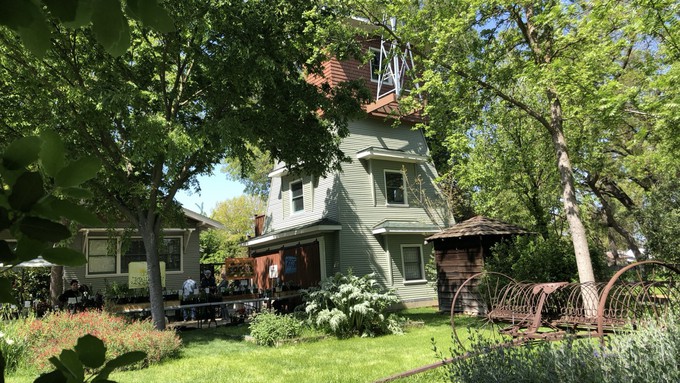
Find member-grown perennials, natives, succulents, vegetables, herbs and more

The historic Azevedo-Moll tank house in South Natomas will be open for tours during the Perennial Plant Club sale on the site. Kathy Morrison
Spring has everybody’s green thumbs itching for action. But what to plant?
The Sacramento Perennial Plant Club has hundreds of suggestions as it hosts its annual spring sale Friday and Saturday, April 12 and 13, in South Natomas. The Natomas Garden & Arts Collective is co-sponsor of the two-day event.
Find California natives, succulents, perennials, vegetables (including lots of tomatoes), herbs and many other plants – all grown by local club members. “Our amazing, hard-working propagators are supplying sun-to-shade loving perennials, natives, veggies, spring-blooming bulbs and more!” say the organizers.
The sale will be open from 9 a.m. to 1 p.m. both days on the grounds of the historic Azevedo-Moll House, 1911 Bannon Creek Drive, South Natomas, Sacramento. Admission is free and open to the public.
During the event visitors can tour the restored tank house on the property. Tours also will be given of the nearby Grassland Garden Pollinator Habitat Project at specific times: 12:30 p.m. on Friday and 11 a.m. Saturday.
Also during the sale "Stan the Tool Man" will offer kitchen and garden tool sharpening, plus container drilling (holes for pots for those new plants, for example). Glass and yard art will be for sale, and food vendors will offer cinnamon rolls and pierogies. Accompanying all this activity will be Native American flute music.
Some of the rare plants available are particular favorites of club members. For example, Patricia Carpenter grew variegated figwort for the sale. “It is very showy in her garden and often weaves through other plants,” say the organizers. “She uses the leaves in cut bouquets. Its reddish flowers are small and interesting.”
Daisy Mah propagated a pale pink hollyhock gifted to her by fellow club member Therese Ruth along with a back story: The original seedling had been abandoned after a Shepard Center sale and planted next to the center’s parking lot, where it bloomed for six months. Daisy named the hollyhock ‘Shepard’s Pink.’
Looking for natives? For this sale, Marla McLaren grew Woolly Indian Paintbrush, a beautiful low-water native that thrives in her garden. “It provides winter color and is a late winter/spring source of food for butterfly and moth pollinators,” say the organizers. Lorraine Van Kekerix contributed her beloved Douglas iris, which thrives in shady spots with limited summer water.
Abutilon lovers will find a whole forest of flowering maples including ‘Lucky Lantern Yellow,’ grown by LaVille Logan. It’s a dwarf variety that stays under 2 feet tall and wide, thrives in partial shade and attracts bees, butterflies, hummingbirds.
Details: https://sacplants.org/.
-- Kathy Morrison contributed to this post
Comments
0 comments have been posted.Sacramento Digs Gardening to your inbox.
Food in My Back Yard Series
April 1: Don't be fooled by these garden myths
March 25: Fertilizer tips: How to 'feed' your vegetables for healthy growth
March 18: Time to give vegetable seedlings some more space
March 11: Ways to win the fight against weeds
March 4: Potatoes from the garden
Feb. 25: Plant a fruit tree now -- for later
Feb. 18: How to squeeze more food into less space
Feb. 11: When to plant? Consider staggering your transplants
Feb. 4: Starting in seed starting
Sites We Like
Garden Checklist for week of March 30
Your garden doesn’t mind April showers. Get busy now to enjoy those future flowers.
* Get ready to swing into action in the vegetable garden. As nights warm up over 50 degrees, start setting out tomato, pepper and eggplant transplants.
* From seed, plant beans, beets, cantaloupes, carrots, corn, cucumbers, melons, pumpkins, radishes and squash. (Soak beet seeds overnight in water for better germination,)
* Plant onion sets.
* In the flower garden, plant seeds for asters, cosmos, celosia, marigolds, salvia, sunflowers and zinnias.
* Transplant petunias, zinnias, geraniums and other summer bloomers.
* Plant perennials and dahlia tubers for summer bloom.
* Transplant lettuce and cabbage seedlings.
* April is the last chance to plant citrus trees such as dwarf orange, lemon and kumquat. These trees also look good in landscaping and provide fresh fruit in winter.
* Smell orange blossoms? Feed citrus trees with a low dose of balanced fertilizer (such as 10-10-10) during bloom to help set fruit. Keep an eye out for ants.
* Apply slow-release fertilizer to the lawn.